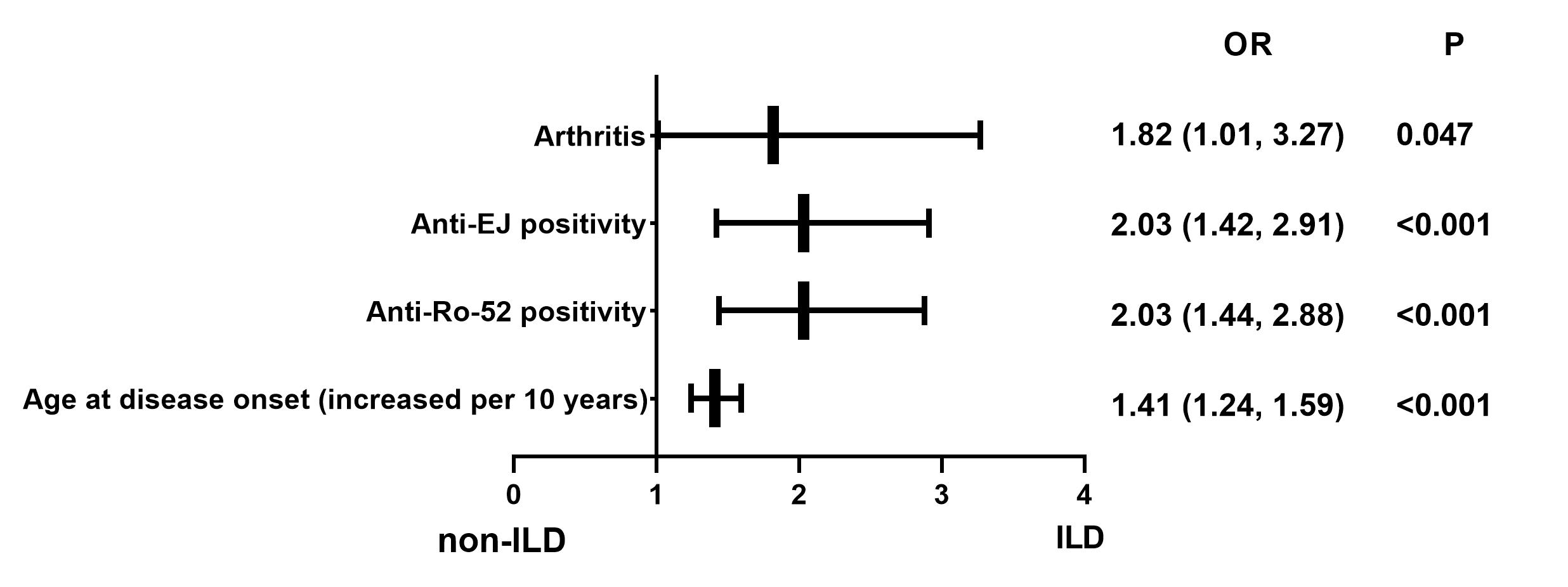Back
Poster Session D
Myopathic rheumatic diseases (polymyositis, dermatomyositis, inclusion body myositis)
Session: (1856β1887) Muscle Biology, Myositis and Myopathies Poster II
1858: A Multi-center Clinical Cohort Study of Chinese Anti-synthetase Syndrome Patients
Monday, November 14, 2022
1:00 PM – 3:00 PM Eastern Time
Location: Virtual Poster Hall
- ζε
ζη ε, MD
Peking Union Medical College
Beijing, Beijing, China
Abstract Poster Presenter(s)
mingwei tang1, Qian Wang1, wei Wei2, Pingting Yang3, Xinwang Duan4, Hongbin Li5, Chanyuan Wu6, JIULIANG ZHAO7, jia shi1, Xiaomei Leng8, Xinping Tian1, MENGTAO LI9, Yan Zhao1 and Xiaofeng Zeng10, 1Peking Union Medical College Hospital, Beijing, China, 2Tianjin Medical University General Hospital, Tianjin, China, 3The First Hospital of China Medical University, Shenyang, China, 4the Second Affiliated Hospital of Nanchang University, Nanchang, China, 5Inner Mongolia Medical University, Hohhot City, China, 6Department of Rheumatology and Clinical Immunology, Peking Union Medical College Hospital, Beijing, China, 7Beijing Union Medical College Hospital, Beijing, China, 8Peking Union Medical College Hospital, Department of Rheumatology and Clinical Immunology, Beijing, China, 9Department of Rheumatology and Clinical Immunology, Peking Union Medical College Hospital, Peking Union Medical College & Chinese Academy of Medical Sciences, National Clinical Research Center for Dermatologic and Immunologic Diseases, Ministry of Science & Technology, Key Laboratory of Rheumatology and Clinical Immunology, Ministry of Education, State Key Laboratory of Complex Severe and Rare Diseases, Ministry of Science & Technology, Beijing, China, 10Department of Rheumatology, Peking Union Medical College Hospital (PUMCH), Chinese Academy of Medical Sciences National Clinical Research Center for Dermatologic and Immunologic Diseases (NCRC-DID), Beijing, China
Background/Purpose: Based on the Chinese Rheumatology Data Center Inflammatory Myopathy Registry (CRDC-MYO), this study aimed to describe the baseline characteristics of a subgroup of patients with anti-synthetase syndrome (ASS), and to explore the risk factors associated with the prevalence of interstitial lung disease (ILD) in ASS patients.
Methods: ASS patients, who were registered in the CRDC-MYO from September 2012 to January 2022, were included in the present study. The baseline data at the time of enrollment were collected, including the demographic, clinical and laboratory characteristics, and treatment regimen as well. The risk factors of ILD in ASS patients were analyzed by multivariable logistic regression.
Results: This study included 750 ASS patients from 114 clinical center around China, 577 (76.9%) of whom were female. The average age at disease onset was (48.2±14.4) years old. The most common clinical manifestations were myositis (77.2%), rash (76.3%), mechanic hands (70.4%), and ILD (70.3%). Anti-Jo-1 antibody was the most common anti-synthetase antibody (61.4%), followed by anti-PL-7 antibody (25.0%), anti-EJ antibody (15.3%), and anti-PL-12 (12.1%). Anti-Ro-52 antibody was the most common myositis-associated antibody (70.9%). 90.8% of ASS patients received glucocorticoid therapy, and the most common immunosuppressant was cyclophosphamide, followed by tacrolimus (13.4%) and cyclosporine A (9.4%). The average forced vital capacity was 74.3±17.5%, the average forced expiratory volume in the first second was 74.3±17.9%, while diffusing capacity of the lungs for carbon monoxide was 58.8±18.8%. The most common HRCT ILD pattern was non-specific interstitial pneumonia (59.2%). The independent risk factors associated with ILD included: older age at disease onset, anti-EJ and anti-Ro-52 positivity, and arthritis.
Conclusion: This study describes the cross-sectional characteristics of a so-far largest Chinese multi-center ASS cohort. The risk factors of ILD identified in ASS patients provides evidence for the early screening and diagnosing of ASS related ILD.

Disclosures: m. tang, None; Q. Wang, None; w. Wei, None; P. Yang, None; X. Duan, None; H. Li, None; C. Wu, None; J. ZHAO, None; j. shi, None; X. Leng, None; X. Tian, None; M. LI, None; Y. Zhao, None; X. Zeng, None.
Background/Purpose: Based on the Chinese Rheumatology Data Center Inflammatory Myopathy Registry (CRDC-MYO), this study aimed to describe the baseline characteristics of a subgroup of patients with anti-synthetase syndrome (ASS), and to explore the risk factors associated with the prevalence of interstitial lung disease (ILD) in ASS patients.
Methods: ASS patients, who were registered in the CRDC-MYO from September 2012 to January 2022, were included in the present study. The baseline data at the time of enrollment were collected, including the demographic, clinical and laboratory characteristics, and treatment regimen as well. The risk factors of ILD in ASS patients were analyzed by multivariable logistic regression.
Results: This study included 750 ASS patients from 114 clinical center around China, 577 (76.9%) of whom were female. The average age at disease onset was (48.2±14.4) years old. The most common clinical manifestations were myositis (77.2%), rash (76.3%), mechanic hands (70.4%), and ILD (70.3%). Anti-Jo-1 antibody was the most common anti-synthetase antibody (61.4%), followed by anti-PL-7 antibody (25.0%), anti-EJ antibody (15.3%), and anti-PL-12 (12.1%). Anti-Ro-52 antibody was the most common myositis-associated antibody (70.9%). 90.8% of ASS patients received glucocorticoid therapy, and the most common immunosuppressant was cyclophosphamide, followed by tacrolimus (13.4%) and cyclosporine A (9.4%). The average forced vital capacity was 74.3±17.5%, the average forced expiratory volume in the first second was 74.3±17.9%, while diffusing capacity of the lungs for carbon monoxide was 58.8±18.8%. The most common HRCT ILD pattern was non-specific interstitial pneumonia (59.2%). The independent risk factors associated with ILD included: older age at disease onset, anti-EJ and anti-Ro-52 positivity, and arthritis.
Conclusion: This study describes the cross-sectional characteristics of a so-far largest Chinese multi-center ASS cohort. The risk factors of ILD identified in ASS patients provides evidence for the early screening and diagnosing of ASS related ILD.

Disclosures: m. tang, None; Q. Wang, None; w. Wei, None; P. Yang, None; X. Duan, None; H. Li, None; C. Wu, None; J. ZHAO, None; j. shi, None; X. Leng, None; X. Tian, None; M. LI, None; Y. Zhao, None; X. Zeng, None.

